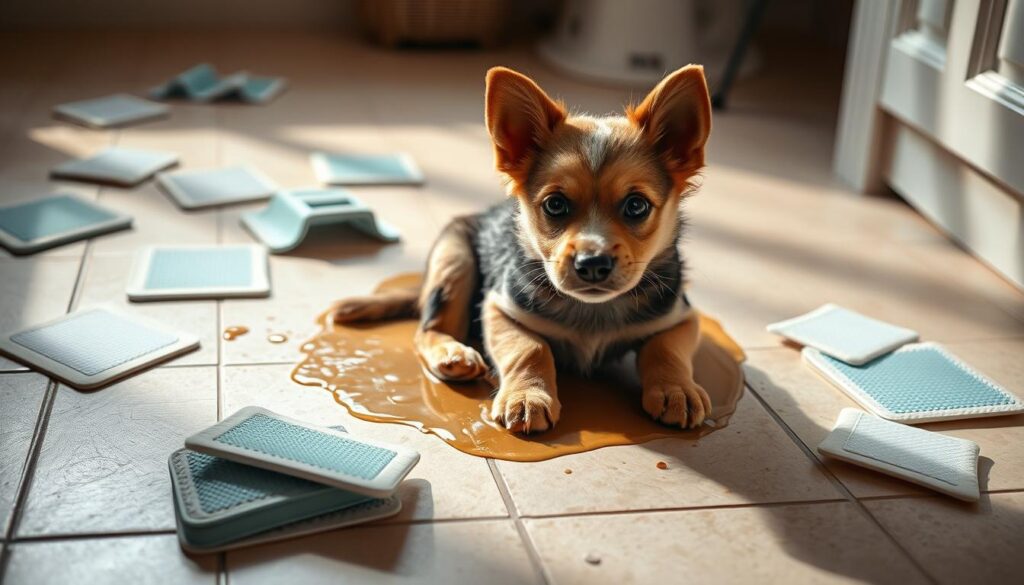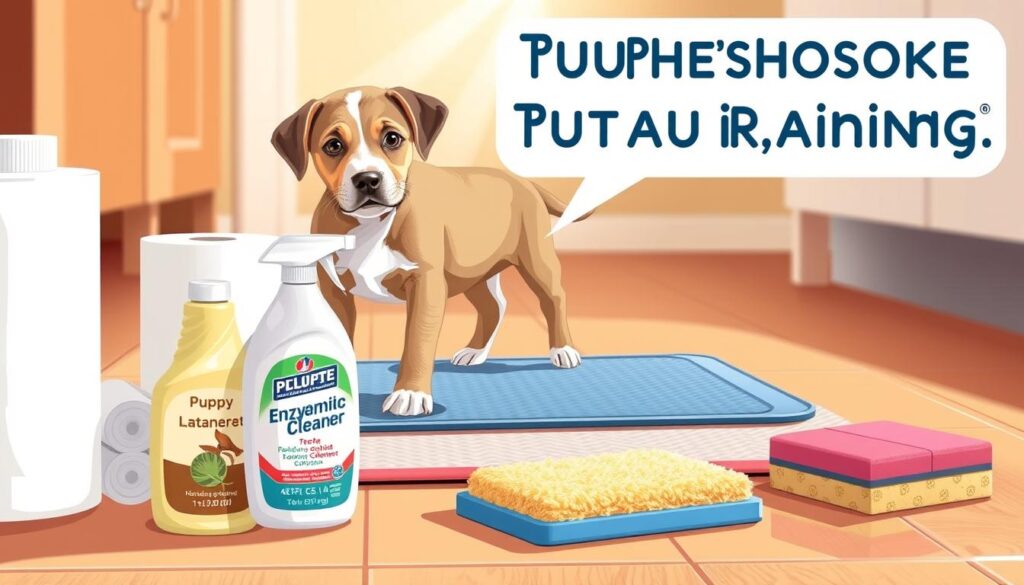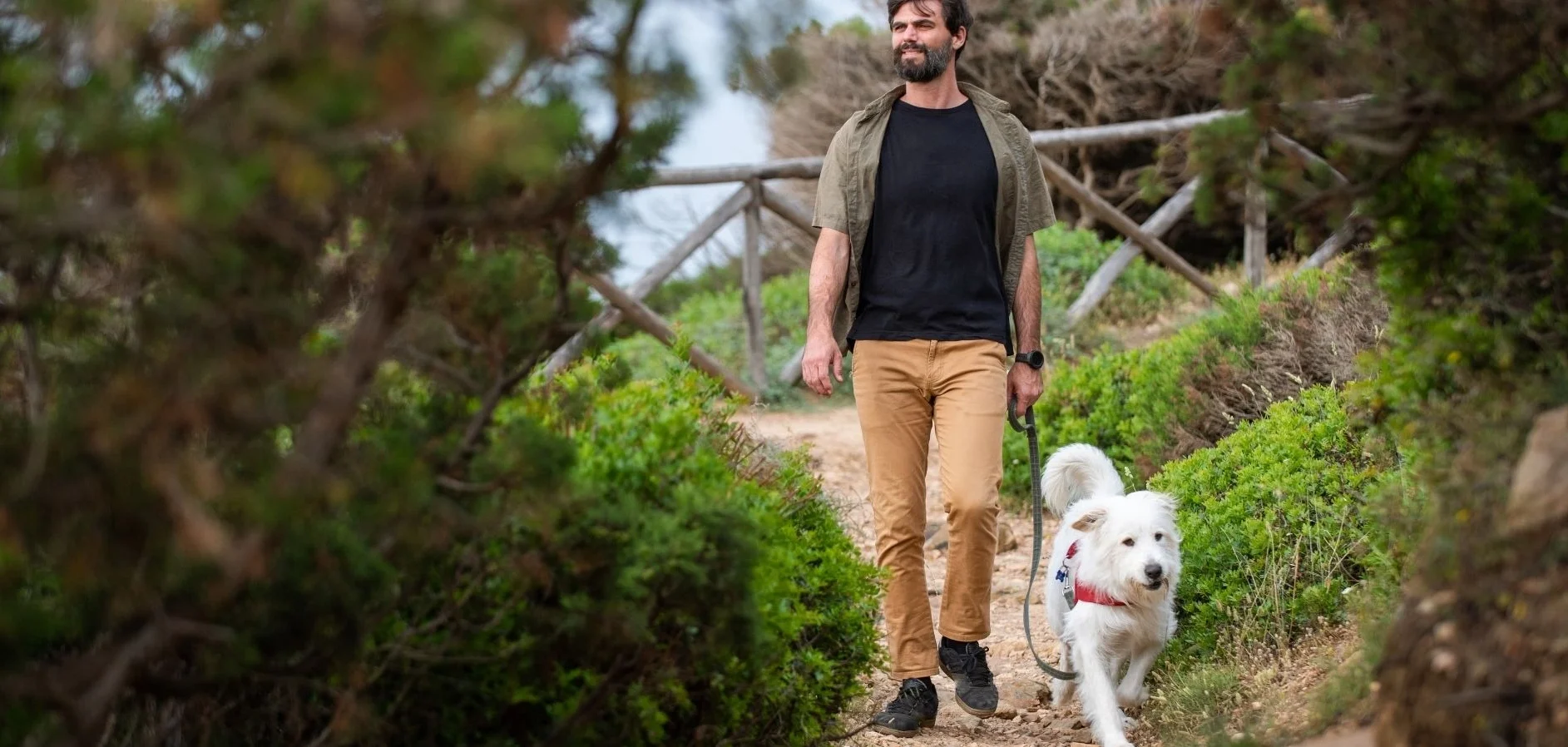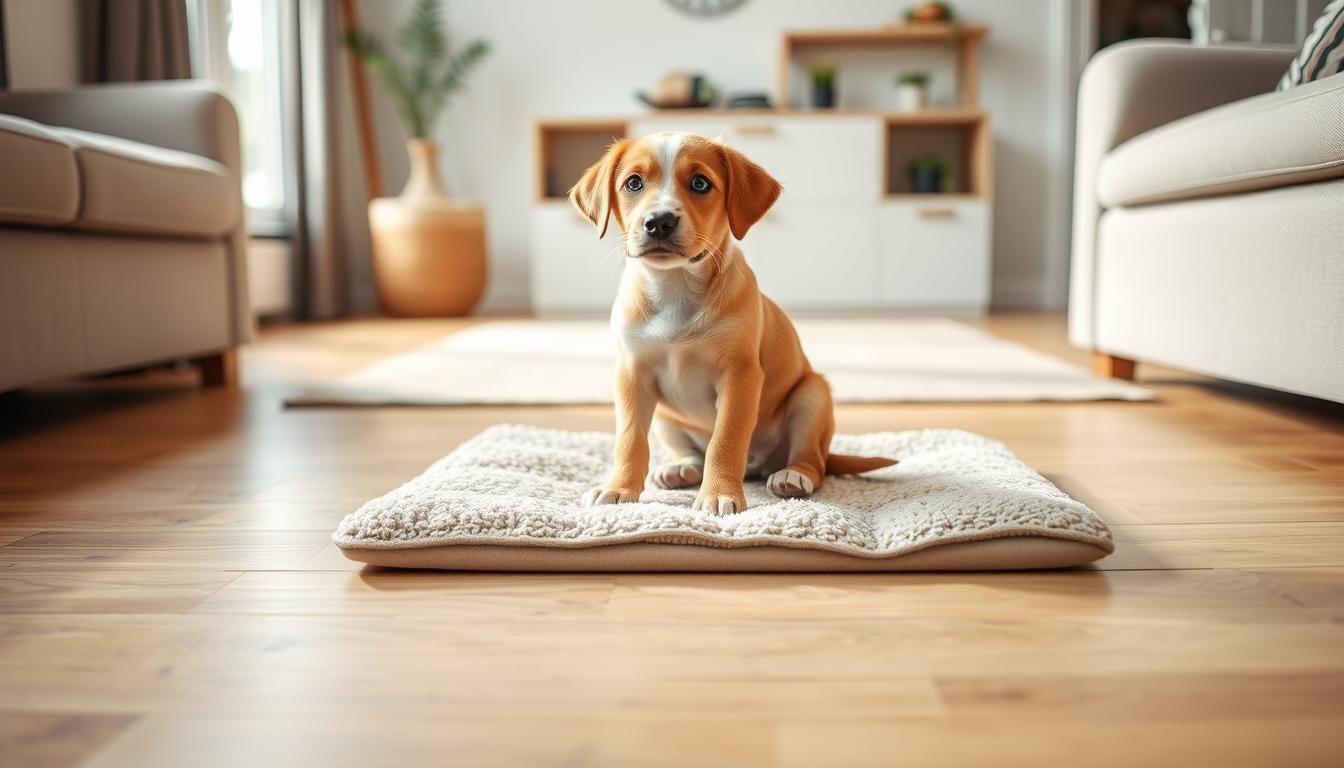Puppy Pad Training 101: Tips for a Clean Home
Table of Contents
Bringing a new puppy home is an exciting adventure. It comes with joy and challenges. Puppy pad training is a smart way to keep your home clean and teach your puppy good bathroom habits.
Every new puppy owner faces the challenge of accidents and keeping their home clean. Puppy pad training is your secret tool for these early days. It helps you teach your puppy where and when to go to the bathroom.
This guide will teach you everything about puppy pad training. You’ll learn how to pick the right pads and create a training schedule. You’ll gain the confidence and skills to housebreak your new friend.
Key Takeaways
- Puppy pad training is an effective method for indoor potty training
- Consistency and positive reinforcement are crucial for success
- Choose the right location for training pads
- Select appropriate pads based on your puppy’s size and needs
- Patience is key during the housebreaking process
Understanding the Basics of Puppy Pad Training
Puppy pad training is key for new dog owners wanting a clean home. Potty training pads help manage your puppy’s bathroom needs early on.
Dog training pads have many benefits. They create a special bathroom area. This protects your floors and helps your puppy learn to go in one place.
Benefits of Using Training Pads
- Convenient indoor potty solution for young puppies
- Protects floors and carpets from accidents
- Helps establish predictable bathroom routines
- Ideal for apartments and homes without immediate outdoor access
When to Start Pad Training
The best time to start potty training pads is between 8-16 weeks. Young puppies can’t control their bladders well. So, pads are a great first step.
| Puppy Age | Training Approach |
|---|---|
| 8-10 weeks | Intensive pad training |
| 10-16 weeks | Gradual outdoor transition |
| 16+ weeks | Primarily outdoor training |
Essential Equipment Needed
To use dog training pads well, you need some basic items.
- Absorbent training pads
- Pad holder or tray
- Cleaning supplies
- Treat rewards
Pro tip: Choose high-quality, leak-proof training pads with maximum absorption. This will help prevent accidents and make cleaning up easier.
Choosing the Right Location for Training Pads
Finding the best spot for your indoor dog potty is key for successful training. The right place can help your puppy learn to use training pads fast.
Think about these important points when picking a spot for puppy training pads:
- Accessibility: Choose a location your puppy can easily reach
- Quiet area: Select a space away from high-traffic zones
- Minimal distractions: Avoid areas near food and water bowls
- Easy cleanup: Pick a spot with hard, cleanable flooring
Your indoor dog potty area should be consistent and predictable. Puppies do well with routine. Keeping the same spot helps them know where to go.
Avoid changing the pad’s position frequently, as this can confuse your young pup.
Here are some good spots for puppy toilet training:
- Bathroom or laundry room with tile floors
- Corner of a home office or spare room
- Enclosed balcony or enclosed patio area
- Utility room with easy-to-clean surfaces
Remember, the indoor dog potty should be close but not too close. It should be near where your puppy sleeps and plays but not right next to their food or bed.
Selecting the Best Puppy Training Pads for Your Pet
Choosing the right pet training pads is key for your puppy’s potty training. The market has many puppy training aids. They help new pet owners teach their pets where to go potty.
When picking training pads, consider a few important factors. These factors affect how well they work and how easy they are to use.
Disposable vs. Reusable Pads
You’ll find two main types of pet training pads:
- Disposable pads: Fast and easy for those with busy lives
- Reusable pads: Save money and are better for the planet
Size and Absorption Considerations
| Pad Size | Recommended For | Absorption Level |
|---|---|---|
| Small (22×22 inches) | Toy and small breed puppies | Low to Medium |
| Medium (23×36 inches) | Medium breed puppies | Medium |
| Large (30×36 inches) | Large breed puppies | High |
Eco-friendly Options Available
For those who care about the planet, there are green puppy training aids. Look for biodegradable pads made from renewable materials. They’re good for the environment and work well.
“The right training pad can make potty training smoother and more enjoyable for both you and your puppy.” – Professional Dog Trainer
Creating a Consistent Training Schedule
Getting your puppy to use a pad is all about a steady routine. Puppies have small bladders and can’t control their pee well. So, a regular schedule is vital for housebreaking.
When you make a training plan, think about a few important things:
- How old your puppy is
- When you feed them
- How much water they drink
- How active they are
Puppies need to go to the pad at certain times:
- Right after waking up
- 15-30 minutes after eating or drinking
- After playing
- Before bed
For puppy pad training, take your puppy to their pad every 1-2 hours during the day. Young puppies (8-12 weeks) need more breaks than older ones.
Watch your puppy’s habits and change the schedule if needed. Being consistent helps them learn good bathroom habits and reduces accidents.
“Patience and persistence create successful training outcomes.” – Professional Dog Trainer
Positive Reinforcement Techniques in Pad Training
Training your puppy to use potty training pads is a fun bonding experience. It’s all about using positive reinforcement. The right methods make pad training enjoyable for both you and your puppy.
Effective Reward Systems
Creating a good reward system is key for dog training pads. Puppies learn best with immediate and consistent praise. Here are some important tips:
- Use high-value treats specifically for pad training
- Offer treats within 3 seconds of successful pad use
- Choose small, soft treats that can be eaten quickly
Verbal Commands and Signals
Clear communication is vital for your puppy to know where to go. Use a consistent verbal cue like “Go potty” when guiding them. Also, use a specific hand signal to reinforce the message.
| Command Type | Recommended Approach |
|---|---|
| Verbal Cue | Use same 2-3 word phrase consistently |
| Hand Signal | Point to potty training pads while giving verbal command |
| Tone | Soft, encouraging voice |
Building Positive Associations
Make dog training pads a welcoming space for your puppy. Place pads in quiet, easy-to-reach areas. Make sure they feel comfortable and safe when they go. Patience and consistent positive reinforcement are essential for successful pad training.
Common Mistakes to Avoid During Training

Puppy toilet training can be tough. Many pet owners make mistakes that slow down the process. Knowing these common errors can help you train your puppy better.
Some key mistakes to avoid include:
- Inconsistent Training Schedule: Your puppy needs a steady routine. Changing the schedule or timing can confuse them.
- Negative Punishment: Scolding or punishing for accidents can make your puppy anxious and slow their training.
- Unrealistic Expectations: Young puppies can’t control their bladders well. They can’t learn to use the indoor dog potty right away.
Being patient is crucial for successful training. Puppies learn at their own pace. Keep your training gentle and consistent. Don’t get upset when mistakes happen – they’re part of learning.
Here are more mistakes to watch out for:
- Failing to clean accidents well
- Not praising your puppy when they use the pad correctly
- Using the wrong type of training pads
- Not taking your puppy for regular potty breaks
Every puppy is different. What works for one might not work for another. Be flexible, watch your puppy’s progress, and adjust your training as needed.
Transitioning from Indoor to Outdoor Potty Training
It’s time to move your puppy from indoor pet training pads to outdoor bathroom breaks. This step is key in your puppy’s growth. It needs patience, consistency, and a good plan to succeed.
Outdoor potty training is about knowing when your puppy is ready. It also means using a clear plan. Young puppies need a lot of help during this time.
Gradual Transition Approach
Start by making a smooth move from indoor pads to outdoor potty habits:
- Slowly move training pads closer to the exit door
- Reduce pad size little by little
- Introduce outdoor potty area while keeping pads available
- Slowly cut down on indoor pad use
Timing Considerations
Choosing the right time to start is key for puppy training. Most puppies are ready between 3-6 months. This depends on their breed and how fast they grow.
| Puppy Age | Transition Strategy | Recommended Frequency |
|---|---|---|
| 3-4 months | First outdoor introduction | Every 1-2 hours |
| 4-6 months | Less pad use | Every 2-3 hours |
| 6+ months | Full outdoor transition | Every 3-4 hours |
Managing the Change
For outdoor potty training to work, use positive reinforcement. Praise and reward your puppy right after they go outside. This encourages good behavior.
Remember, every puppy learns in their own way. Be patient and keep training. Your puppy will learn to go outside like a pro.
Maintaining Cleanliness and Hygiene
Puppy pad training needs careful attention to cleanliness and hygiene. Keeping your training area clean protects your puppy and home from health risks. Regular cleaning stops odors and keeps a healthy space for your pet.
Effective puppy housebreaking is more than just using pads. You must also clean and sanitize the training area well.
- Clean pads immediately after use
- Use enzymatic cleaners to eliminate odors
- Disinfect surrounding areas weekly
- Replace training pads frequently
Choose cleaning products made for pet accidents. Enzymatic cleaners break down organic matter and get rid of odors better than regular cleaners.
| Cleaning Product | Effectiveness | Cost |
|---|---|---|
| Enzymatic Cleaner | High | $10-$20 |
| Vinegar Solution | Medium | $2-$5 |
| Bleach Solution | Low | $1-$3 |
Your puppy pad training success depends on a clean, hygienic space. Regular cleaning stops bacteria and helps your puppy learn good bathroom habits.
A clean training area is key to successful puppy housebreaking.
Troubleshooting Puppy Pad Training Issues
Puppy pad training can be tricky. You might face challenges that test your patience and skills. Knowing how to handle these issues can make training easier and less stressful.

Every puppy learns in their own way. Setbacks are normal. The key is to stay consistent and calm when facing challenges.
Dealing with Accidents Effectively
Accidents are part of the learning process. Here’s how to handle them:
- Clean the area with an enzymatic cleaner
- Avoid punishing your puppy
- Redirect them to the potty training pads after an accident
- Reinforce good behavior with praise
Addressing Training Resistance
Some puppies might resist using dog training pads. This could be due to:
- Incorrect pad placement
- Uncomfortable pad texture
- Not enough positive reinforcement
Pro tip: Try different pad locations and types to see what your puppy prefers.
Overcoming Training Plateaus
Training plateaus can be tough. If your puppy seems stuck, try these tips:
- Change your reward system
- Train more often
- Check for health issues
- Get help from a professional dog trainer if needed
Remember, being persistent and patient is key to successful puppy pad training.
Special Considerations for Different Breeds and Ages
Puppy toilet training isn’t a one-size-fits-all process. Different dog breeds and ages need unique approaches. Understanding these special considerations helps create a more effective training strategy for your furry friend.
Breed characteristics are key in puppy toilet training success. Small breeds like Chihuahuas and Yorkshire Terriers have smaller bladders. They need more frequent potty breaks. Large breeds, such as Great Danes, might take longer to develop bladder control.
- Toy Breeds: Require more frequent indoor dog potty training sessions
- Working Breeds: Often learn quickly and respond well to structured training
- Older Dogs: May need additional patience during puppy toilet training
Age is another critical factor in training effectiveness. Puppies under 12 weeks have limited bladder control. They need consistent, gentle guidance. Senior dogs might struggle with new training techniques due to established habits or potential health issues.
| Breed Size | Training Complexity | Recommended Approach |
|---|---|---|
| Small Breeds | High | Frequent short sessions |
| Medium Breeds | Moderate | Consistent routine |
| Large Breeds | Low | Gradual training |
Remember, patience and consistency are key in any puppy toilet training approach. Each dog is unique. What works for one might not work perfectly for another.
Alternative Indoor Potty Training Methods
Pet training pads aren’t the only way to train your puppy indoors. Puppies have different needs, and many other tools can help with their bathroom habits.
Artificial grass pads give your puppy a feel of being outside. They look and feel like real grass, making it easier for your puppy to go from inside to outside. They come with:
- Drainage systems to keep surfaces dry
- Replaceable grass patches
- Realistic texture similar to outdoor terrain
Small breed owners might find litter box training a good option. It’s surprisingly effective for small dogs. These systems are:
- Minimal space requirements
- Easy cleanup
- Convenient for apartment living
Indoor potty systems with special surfaces are also great alternatives. Some designs include absorbent mats with scent attractants and washable surfaces.
When picking an alternative, think about your home, your puppy’s age, breed, and how they learn. Each method has its own advantages. Try different ones to see what works best for your puppy.
Conclusion
Puppy pad training is key to a clean home. It helps you and your puppy live in harmony. By following the tips in this guide, you can handle puppy housebreaking with ease.
Every puppy is different, and being consistent is crucial. Understanding your puppy’s needs and using positive rewards are important. This helps them learn good habits.
Keep your eyes on the future as you train your puppy. With effort and the right methods, your puppy will learn to go potty indoors. Celebrate every small victory on your journey.
Investing in puppy pad training strengthens your bond with your pet. It also keeps your home clean and comfortable. Stay committed, and watch your puppy become a well-behaved friend.
There are no reviews yet. Be the first one to write one.


